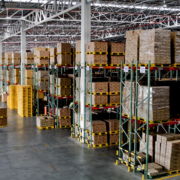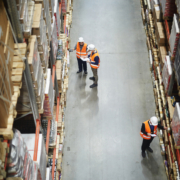An Industrial Relocation Company’s Warehouse Transition Plan
Whether you have outgrown your previous space, need a downgrade, or are moving for geographic reasons, developing a warehouse transition plan is crucial for success. Going into a complex move without a strategy can feel like moving skids without a pallet jack. To make the process easier, think about every component of your move early and often. This will help prepare you and your team for the massive undertaking that lies ahead.
Every facility requires a unique strategy, so finding a ready-made guide for your specific situation is impossible. This warehouse transition plan serves as a starting point for planning the relocation, but contacting an experienced industrial relocation company is the best way to ensure everything is handled.
Components of a Warehouse Transition Plan
There is an overwhelming amount of preparation involved with planning a warehouse move. Reserve a heavy equipment transportation freighter 6-12 months in advance to ensure availability for your anticipated move. Establishing your move date and giving yourself a tangible deadline enables you to begin setting progress goals that ensure your move goes smoothly.The components of your warehouse transition plan include:
1) Finding a Space
2) Administrative Work
3) Shipping, Receiving, and Inventory
4) Decommissioning Old Space
5) Transportation
6) Settling into Your New Space
1) Finding a Space
First, you will need to identify prospective spaces and make sure that they are suitable for your needs. There are many things to consider during this phase, and it is arguably one of the most important steps. Obtain floor plans and use CAD software to ensure the new warehouse meets your space requirements. Pay special attention to ceiling heights and account for sprinkler systems. This will help determine if your current racking will fit in the new warehouse.
Moving to a new location also allows you to establish a more efficient operation, so identify potential improvements and challenges during your search:
• Are there any areas of the warehouse that are prone to congestion?
• Is popular inventory easily accessible?
• Are aisles wide enough for forklifts to easily maneuver?
• Is there ample parking and public transportation for employees?
2) Administrative Work
Once your new location has been decided, the administrative work will begin. From finalizing the lease to vendor and employee relations, the administrative work consumes a lot of bandwidth. Ideally, your warehouse transition plan will have a dedicated project manager handling all aspects of the move without having to split their focus on operational tasks. If you aren’t able to have one dedicated person handle all tasks, assign individual members of your team a specific role. The individual project managers should maintain an open line of communication and provide regular updates to each other.
Warehouse Transition Employee Roles
• Lease Coordination: Depending on the size of your move, there will be at least two leases in play. Finalizing the lease and securing a move-in date for the new location will be priority one. Once you have accomplished this, focus on exiting your current lease.
• Freight Acquisition: Moving heavy equipment and pallets of inventory relies on specialty freight trucks. These vehicles tend to have a long wait time for booking, so early planning is key to securing the necessary freight.
• Inventory and Productivity Management: Moving an entire warehouse typically means disrupting your supply chain. By dedicating an employee to manage inventory and productivity, you stand the best chance of maintaining fulfillment during the move.
• Personnel Planning: Responsible for maintaining communication with employees and determining staffing requirements at the new location. Whether it’s packing inventory, cleaning, or breaking down equipment, most employees will have an additional job to help prepare for the move. The personnel planner needs to make sure that the employees know how they will help during the move. Keep the employees up to speed on the progress of the move and make them aware of specific deadlines for their assigned tasks.
• Vendor Relations: Suppliers, utility companies, government agencies, customers, and partners. All of these groups will be affected by your move, and they must be made aware of your plan to relocate. The person in charge of vendor relations will need to communicate the change of address and date of completion to all parties.
3) Shipping, Receiving, and Inventory
If you designated individual project managers to handle each task in step 2, the inventory and productivity management appointee will need to determine when purchase order deliveries should be received at the new location. Diverting shipments to the new location will cut back on the amount of inventory that needs to be moved. It can also help minimize costs and expedite the transition.
A second important component of inventory logistics is creating a designated area for continued operations in your existing space. If your layout permits you to do so, keeping an area that operates independently of the rest of the warehouse will help to decrease the potential chaos of a transition and keep operations running smoothly.
One final consideration related to shipping, receiving, and inventory relates to determining how inventory will move through the location. Consult the floor plans and outline an inventory flow to show how inventory will be received, stored, and shipped. This is your chance to optimize the process and correct any inefficiencies in your current flow.
4) Decommissioning Old Space
The most laborious step of your warehouse transition plan involves physically preparing for the move. Decommissioning a warehouse involves many of the same tasks involved with decommissioning an office space. However, the larger scale of the furniture, fixtures, and equipment (FF&E) requires additional effort and planning.
Each employee will most likely have a task to prepare for the move. The task could involve taking a physical inventory at the SKU level. It could also involve more traditional decommissioning tasks like packing, tearing down equipment, and cleaning. If you find that your workforce is stretched too thin, and can’t finish the warehouse decommission in time, you must outsource the work.
When decommissioning the old space, pay attention to dead and aged inventory that will not be moving to the new location. This inventory can be donated for tax benefits or disposed of, usually for a fee. Eliminating the unnecessary inventory before the move will help decrease overall stress and make the project less overwhelming.
TIP: Determine the storage locations at the new warehouse early on and assign each bay an identifying code. When you are loading and shrink-wrapping pallets at your old location, mark each pallet with the appropriate code to make re-stocking the new warehouse easier.
5) Transportation
Moving the equipment to your new location is a massive undertaking, and you should make arrangements well in advance. We recommend securing the freight trucks at least 6 months before your planned move date to ensure their availability. If your warehouse requires specialty vehicles, such as reefers or other climate-controlled transportation, you may need to start planning even sooner.
You will also need to ensure that you have the appropriate rigging to move the heavy equipment and machinery that populates your warehouse. Failing to obtain qualified operators can result in irreparable damages and costly delays. We recommend looking for a CCO-certified operator who has a verifiable history of success.
Moving the inventory is the final piece of the transportation phase, and it requires the most thought. Strategically staging the inventory for transportation will help your warehouse continue to operate during the otherwise tumultuous period of relocation. Pay special care to maintain accurate documentation of inventory during the transition period.
6) Settling into Your New Space
Since you took care to organize your inventory and performed detailed space planning for the new location, settling into the new warehouse will be relatively straightforward. If you haven’t already informed the appropriate parties of your move, now is the time to make everyone aware of your new address. Below is a list of parties who should know that your address has changed. Please note that this list is not comprehensive, and you may need to notify additional parties of your move.
• Utility companies (Electric, water, internet, gas)
• Customers
• Banks and financial institutions
• Insurance companies
• Food and beverage services
• Business partners
• Government agencies (IRS, Secretary of State, Postal Service, local tax collector)
Other than physically settling in and communicating your new location to relevant stakeholders, you will need to bring your employees up to speed on the procedures for the new location. We suggest holding an orientation in which you implement a walkthrough of the new space with your team. They should be briefed on safety protocols, provided with appropriate security and entrance codes, informed of parking procedures, given internet access information, and made aware of any new changes.
Help from an Industrial Relocation Company
One person cannot handle all of the moving parts involved with an industrial relocation. Having a warehouse transition plan helps organize the undertaking, but your best chance for an efficient and stress-free move is to seek the services of an industrial relocation company. By delegating the task to an experienced professional, your team can focus on doing what they do best while the relocation project manager handles the tedious details.
At Relocation Strategies, we have been providing relocation services for industrial companies for over 25 years. During that time we have developed a reliable network of vendors who are trustworthy and efficient. If you are planning an industrial move, whether it’s a factory, warehouse, lab, or other industry that requires specialized transportation equipment and advanced logistics, you don’t have to go at it alone. Chat with one of our industrial relocation project managers today to see how we can remove stress from your relocation.












Leave a Reply
Want to join the discussion?Feel free to contribute!